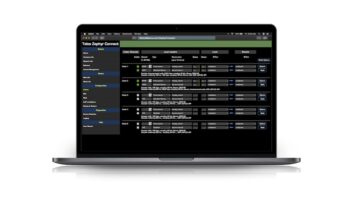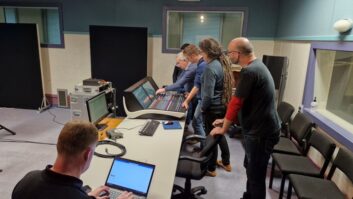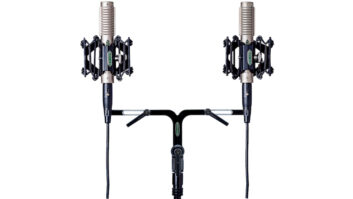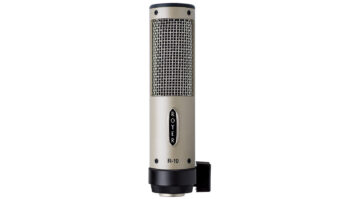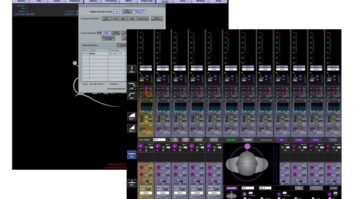Image of Brian Vibberts (kneeling) with the Jive Aces.
Burbank, CA… The Jive Aces are the UK’s top Jive & Swing band. Together for over a decade, this extremely popular six piece group has performed at thousands of festivals, theaters, and events throughout the UK, Europe, and the USA, as well as Japan, Israel, and the Caribbean. During March and the latter part of 2010 (in-between, they toured), the band could be found at LA’s venerable Mad Hatter Studios recording King of the Swingers, their latest album effort on the Golden Age Recordings label. There’s some amazing instrumental performances captured as part of this endeavor and they wouldn’t have happened had it not been for the engineering talents of Brian Vibberts and his collection of Royer Labs ribbon microphones.
Working with a pair each of Royer Labs R-121 and R-122 ribbon microphones as well as the company’s highly acclaimed SF-24V stereo vacuum tube ribbon mic, Vibberts and his second engineers Buck Snow and Ryan Cota have created an impressive recording with a gorgeous sound that captures all the live energy jazz musician Louie Prima had. All tracks on King of the Swingers are written by Louie Prima.
Vibberts was the ideal choice to engineer and co-produce (with producer Vince Hurley) the new Jive Aces album. He’s a multiple Grammy® Award winner, capturing top honors in the Jazz Album of the Year category for his efforts on The New Crystal Silence with Chick Corea and Gary Burton as well as John McLaughlin’s and Chick Corea’s Five Peace Band. Perhaps even more notable is his work on Michael Jackson’s History.
Vibberts discussed his reason for using Royer ribbons, “I’ve always been a fan of ribbon mics, and so I frequently used several of the old RCA ribbon mics in the past. When I first learned of Royer Labs’ ribbon mics, I was very interested, especially because of the active electronics used in their models. When I tried the Royers, I immediately heard the warmth and the realistic sound the mics captured. I was also very impressed with their extremely low noise floor.�
“We used the R-121 and R-122 on the saxophone, trombone, and trumpet,â€? he continued. “For us, ribbon microphones are a necessity when recording brass instruments, and Royers deliver top notch sound quality. They truly capture the full body and warmth of brass instruments, but have the presence and clarity to convey the energy and excitement which is a major part of The Jive Aces.â€?
“The Royers were clearly the best mic choice for this project,� Vibberts said. “Part of this is because of the mics’ ability to handle high SPL’s (these horns were loud) and the other part is because of the microphones’ figure 8 polar pattern. By having the trumpet and sax standing side by side, I could use the nulls to isolate the two players from one another—giving me excellent separation.�
“I actually positioned these two players in the room exactly where I wanted them in the mix,� he explained. “By working this way, I could put up the SF-24V for room ambience and have that microphone’s signal reinforce the imaging of the R-121 and R-122. The stereo imaging matched up perfectly and, together, it created a really big sound. I also used the Royers for a lot of Blumlein miking technique on this project (two matched microphones, positioned 90° from each other). The Royers are perfect for this application and, as a result, I captured a really broad stereo image.�
In addition to room ambience, Vibberts’ SF-24V was also used for a not so conventional application, as he discussed. “I used the SF-24V where one capsule was facing the body of the acoustic guitar and the mic’s second capsule was parallel with the instrument’s neck,� he said. “By working this way, I was able to capture the full breadth of the instrument. The sound was so realistic, it was incredible. It was as though the guitarist was positioned directly between the left and right monitors. Just beautiful!�
Vibberts summarized his experience with the Jive Aces project, “We also did some additional recording for some bonus tracks where we recorded a clarinet. I feel as though this is the best clarinet recording I’ve ever heard and, for this, we used a combination of the Royer R-122 and the MA-200 from Royer’s sister company Mojave Audio. It was unreal— absolutely amazing. I’m so proud of that recording; I can’t wait for people to hear it. I’m thrilled with the way the entire album turned out and one principal reason for that sound is the fact that we used the Royer ribbons.�
For more information about Brian Vibberts, visit him online at www.brianvibberts.com. To learn more about the Jive Aces, go to www.jiveaces.com.
About Royer Labs
Located in Burbank, California, Royer Labs’ microphones are a staple of leading recording and broadcast facilities. Additional information on the entire line of Royer Labs microphones and other aspects of the company can be found at www.royerlabs.com.
###
